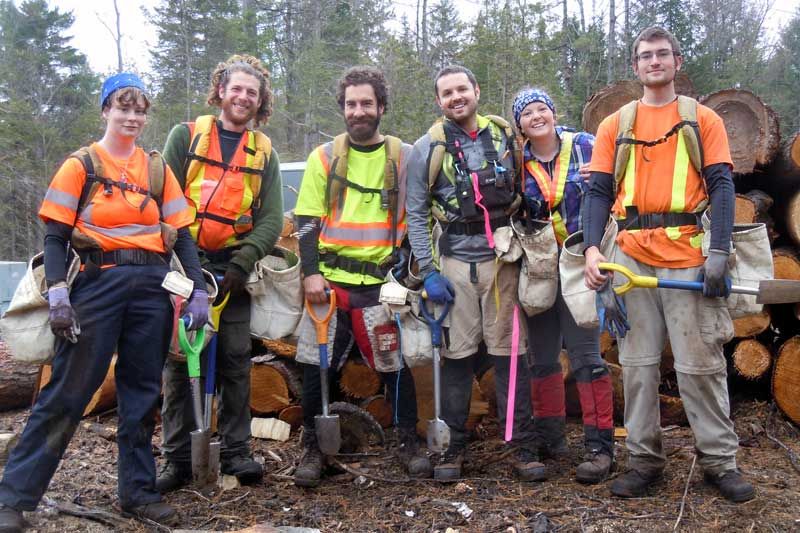May 02, 2013
This past Saturday’s slow, gentle rain and cool temperatures are what tree planters wish for. The crew of six tree planters from Brinkman and Associates welcomed the weather as they planted small seedlings of white and red pine in a tract of recently harvested forest located near Plevna. The tract is managed by Mazinaw Lanark Forest (MLF) Inc.
MLF, whose head office is located in Cloyne, manages roughly 200,000 hectares of forest in an area that stretches north of Denbigh, south of Kaladar, east to the eastern boundary of Lanark County and west to Marmora. MLF Inc. both harvests and plants every year. As part of their mandate for forest renewal they leave 85% of the forest to regenerate naturally and the other 15% they regenerate artificially by planting.
On Saturday the Brinkman's crew were in the process of planting 11,000 white and red pine seedlings on an eight-hectare swath. This is a small percentage of the 265,000 trees that MLF is planting over a 200-hectare sized area. Plevna is just one of 10 or so sites that will be receiving planted seedlings.
“Our obligation is to regenerate what we harvest,” said Jan Smigielski, who is a silviculture forester with Mazinaw Lanark Forest Inc. Regarding the Plevna site, Jan said, “The aim in this case is to maintain the pine component on the site and the decision to plant pine was based on the fact that pine grows very well in this area.”
Red and white pine, but mostly poplar and soft maple, were harvested from the site, which was then prepared for planting prior to the arrival of the Brinkman crew earlier this week. Both the harvesting and preparation were done by a local logger who is also is a member of the MLF.
The 7-10 centimeter seedlings that the young planters put into the ground were grown in the Ferguson Forest Station in Kemptville, a co-op nursery that evolved from a former MNR nursery. Trees have been produced there since MLF Inc. was created in 1998. It will take 60-100 years for the pine seedlings just planted near Plevna to mature and of the youngest of those, many will end being thinned out at a later date. The trees harvested from the Plevna site were sold to various companies and most went to Norampac, a pulp mill in Trenton that will turn the harvested trees into corrugated cardboard packing material.
“The forestry business is a pretty complex system,” Jan said when I interviewed him by phone earlier this week. “It is really all about planning for the very long term.” The company uses numerous harvesting systems including clear cutting, which amounts to roughly 15% of the annual harvest or roughly 1500 hectares a year. The remaining 85% of the MLF harvest is split between the “shelterwood” and “selection” systems. The former is a system that calls for removing the entire over-storey of mature trees in 2 or 3 stages, which usually takes place over 20-40 years. The selection system is a system of harvesting where only certain mature trees are harvested and the remaining forest is left to regenerate naturally. The benefit of the MLF harvest locally is that it helps to employ local loggers who have been in the logging business for generations and who rely on the steady work that yearly harvesting and site prep call for.
For others like the young, able-bodied planters on the Brinkman crew, regenerating forests is a way to make quick, honest bucks, each of which comes with its fair share of sweat, toil and long-term mental toughness.
More Stories
- Harrowsmith Public School and the Magic of Theatre
- You’re a Good Man Charlie Brown – a school wide effort at SHS
- Leadership From Within
- New Bulk Water Station in Sydenham
- Frontenac County Council looks at Healthcare Recruitment
- Good Turn Out Maple Fest Despite Rain
- Future looking brighter for Denbigh Fire Department says Chief
- Local Favourites featured at 2nd Annual SF Music Festival
- Perth Festival of the Maples, Saturday, April 27
- South Frontenac Council

